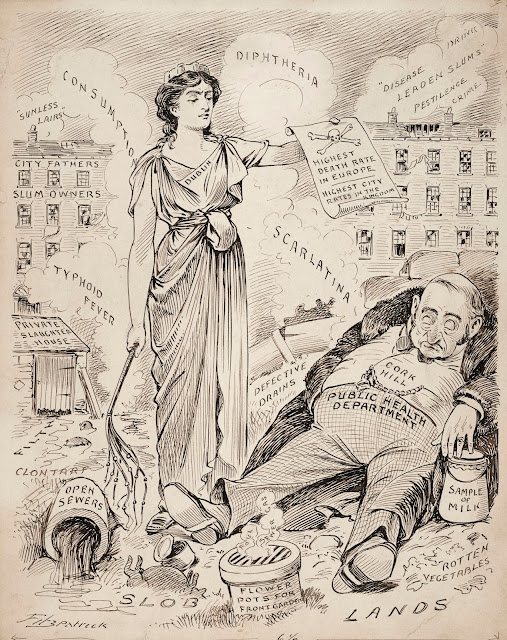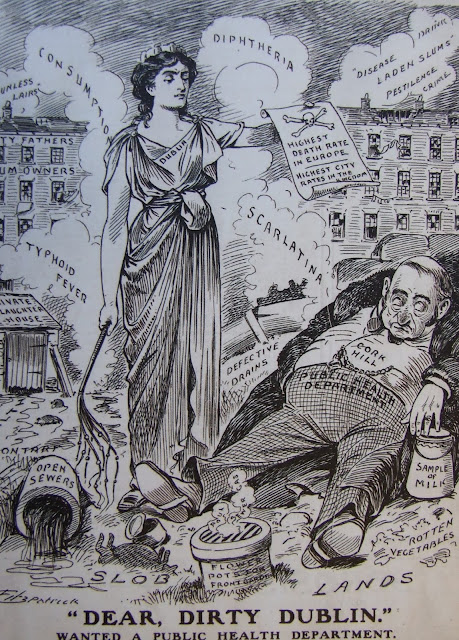Item of the Month: ‘Dear Dirty Dublin’
February’s
item of the Month is one of a set of cartoons, held by the RCPI Heritage Centre,
looking at Public Health issues. The
cartoons all draw attention to the extreme poverty, lack of proper sanitation,
and prevalence of diseases in Dublin at the beginning of the 20th
Century.
 |
| TF/4 - Highest Death Rates in Dublin |
The cartoons
were all drawn by Thomas Fitzpatrick, who
was born in Cork in 1860. He showed artistic talent at a young age, and became
a cartoonist for
nationalist newspapers, as well as an illustrator, and eventually editor of his
own satirical magazine, ‘The Lepracaun.’ Fitzpatrick
was well known for his cartoon illustrations on public hygiene, health and
other issues in Ireland, especially in Dublin.
This
striking image shows just how bad public health, hygiene and poor sanitation
were in Dublin at the start of the twentieth century. Dublin at
the time was a large garrison city, considered to be a beautiful, friendly city
by Queen Victoria. However, this image shows the darker and dirtier side of
Dublin that was largely ignored by the authorities. Dublin was home to the worst slums and had the
highest death rates in Europe at the time.
This was largely due to overcrowding, lack of proper sanitation, clean
facilities, and proper hygiene.
The image shows
a woman, representing the City of Dublin, carrying a cat-o-ninetails and serving
an eviction notice to Dublin Corporation (the fat man slumbering in the chair) and
the rich elite for failing to protect the working class and the poor. Situated behind the woman, are the dilapidated
tenements; the once comfortable and spacious Georgian houses of the rich elite.
One of the worst examples, according to the 1901 and 1911 census, was No 14 Henrietta
Street, in Dublin’s city centre. Once
home to grand families and the Lord Chancellor of Ireland, by 1901, it had 100
occupants; with 17 families living in 45 rooms. Some families, who could not
afford to rent a single room, had to share with other lodgers.
The slums
did have water and privies, usually outside, but shared between so many people
there was extremely poor hygiene and sanitation. These conditions were excellent breeding
grounds for diseases; including tuberculosis, cholera, diphtheria, typhoid,
typhus, smallpox, and dysentery. These can all be seen in the cartoon in clouds
or miasma. Most were airborne contagions
and could wipe out entire families.
 |
| The image as it was published in December 1908 |
Fitzpatrick
published the cartoon in The Lepracaun in
December 1908, with the title ‘Dear Dirty
Dublin’ and, underneath, the appeal ‘Wanted
A Public Health Department’. This was a
call for changes to the terrible conditions which were crippling the
population.
Ruth McCann
Library Intern